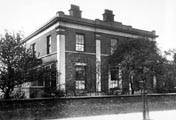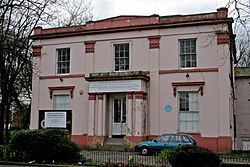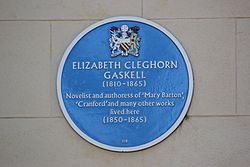84 Plymouth Grove facts for kids
Quick facts for kids 84 Plymouth Grove |
|
|---|---|
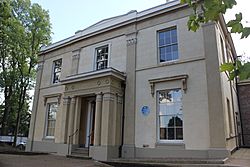
The front façade of 84 Plymouth Grove, now known as Elizabeth Gaskell's House
|
|
| Former names | 42 Plymouth Grove |
| Alternative names | Gaskell House |
| General information | |
| Architectural style | Neoclassical |
| Location | Manchester, England |
| Coordinates | 53°27′49″N 2°13′16″W / 53.46361°N 2.22111°W |
| Completed | c. 1838 |
| Owner | Manchester Historic Buildings Trust |
| Design and construction | |
| Architect | Richard Lane |
| Designations | |
|
Listed Building – Grade II*
|
|
| Official name: Mrs Gaskells House | |
| Designated: | 25 February 1952 |
| Reference #: | 1271082 |
84 Plymouth Grove, also known as Elizabeth Gaskell's House, is a special museum in Manchester, England. It used to be the home of famous writer Elizabeth Gaskell and her husband, William. They lived there from 1850 until Elizabeth's death in 1865 and William's in 1884.
Their daughters continued to live in the house after their parents passed away. The Gaskell family lived in this house for 63 years. It became a museum to celebrate Elizabeth Gaskell's life and her amazing books. The house is a Grade II* listed building, which means it's a very important historical place.
Contents
The House's Story
84 Plymouth Grove was built around 1838. It was designed in the Regency style, probably by an architect named Richard Lane. The house was built for the growing number of middle-class families in Manchester. At that time, Manchester was expanding quickly because of the Industrial Revolution.
The house has 20 rooms spread over two floors, plus a hidden basement. It has a grand front porch with four columns. These columns are carved with a lotus leaf shape, similar to an ancient building in Athens. The front of the house is covered in a special plaster called Stucco. For many years, the house was painted pink, earning it the nickname 'The Pink House'. However, when Elizabeth Gaskell lived there, it was a "stone-colour."
Life with the Gaskells
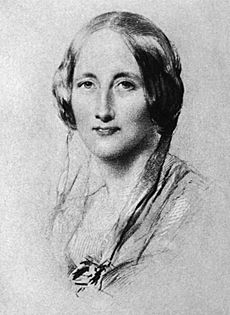
Elizabeth and William Gaskell moved into the house in June 1850. They lived there with their four daughters: Marianne, Margaret Emily "Meta", Florence, and Julia. This move happened after Elizabeth's first novel, Mary Barton, was published. William Gaskell was a minister, and his job brought the family to Manchester.
Elizabeth was a bit worried about living in such a large and expensive house. She felt concerned because many people in Manchester lived in poverty. Even though it cost a lot, the Gaskells were not stingy. They had many domestic staff to help them, including a cook, maids, and a handyman. Elizabeth made sure her staff were well-trained and cared for.
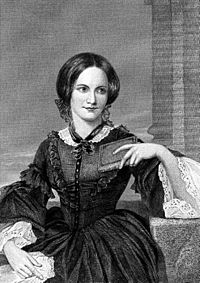
Many famous people visited the Gaskells at 84 Plymouth Grove. Charlotte Brontë, who wrote Jane Eyre, visited three times. She described the house as "a large, cheerful, airy house, quite out of Manchester smoke." The "Manchester smoke" came from the many factories in the city. Charlotte Brontë was quite shy. Once, she even hid behind the curtains because she was too nervous to meet other guests!
The Gaskell home was a busy place, like a "beehive," with many visitors. Besides Charlotte Brontë, other famous guests included Charles Dickens, John Ruskin, and Harriet Beecher Stowe. The musician Charles Hallé also visited often. He even taught Meta Gaskell how to play the piano.
Elizabeth Gaskell wrote many of her most famous books while living here. These include Cranford and North and South. She lived in the house for 15 years until her death in 1865. William Gaskell passed away in 1884. Their two unmarried daughters, Meta and Julia, continued to live in the house. They were both involved in many charitable activities.
The End of an Era
In 1913, Meta Gaskell, the last Gaskell living at Plymouth Grove, passed away. This marked the end of the family's 63 years in the house. Many people thought the house should become a museum to honor Elizabeth Gaskell. The Manchester Guardian newspaper supported this idea.
However, the local council decided not to turn it into a museum. They said the house was not architecturally special, only important because of its connection to the Gaskell family. So, the house was left empty for a while. The University of Manchester bought the building in 1969 and used it for their International Society. The university stopped using the building in 2000.
The house was officially listed as a Grade II* building in February 1952. This protected it from being torn down.
Bringing the House Back to Life
The Manchester Historic Buildings Trust bought the building in 2004. Their goal was to restore it and open it to the public. In 2006, the house was in very bad shape. It had serious cracks in the walls, problems with its foundation, and a lot of dry rot. The entire roof needed to be replaced.
Restoration work began in September 2009. The first phase focused on the outside of the house. A new roof was put on in 2010. However, in May 2011, thieves stole most of the lead from the new roof! This caused a lot of damage and let rainwater into the house. The remaining lead was removed to prevent more thefts, and a new roof was built.
By February 2013, the first phase of restoration was complete. The roof, drains, and structural damage were fixed. The pink paint was removed, and the house was painted an off-white color, like it was in Elizabeth Gaskell's time.
In June 2012, the project received a large grant of £1.85 million. This money allowed them to restore the inside of the house. They restored the bedrooms and reception rooms. They also created a special area for visitors to learn. The grant also helped restore the house's garden, where the Gaskells once kept animals like pigs and a cow.
The ground floor of the house has been carefully restored to look like an authentic Victorian home. Experts researched what the rooms would have looked like when the Gaskells lived there. They borrowed furniture from museums and libraries to make the rooms look just right. They even consulted with art experts to find the correct wallpaper and paint colors.
The upstairs of the house now has rooms for educational activities and community events. Elizabeth Gaskell's House officially reopened to the public on October 5, 2014. The people who run the house hope it will become a popular place for literary tourism. They want it to be as well-known as places like Shakespeare's Birthplace or the Brontë Parsonage Museum.
Gallery
See also
- Grade II* listed buildings in Greater Manchester
- Listed buildings in Manchester-M13


